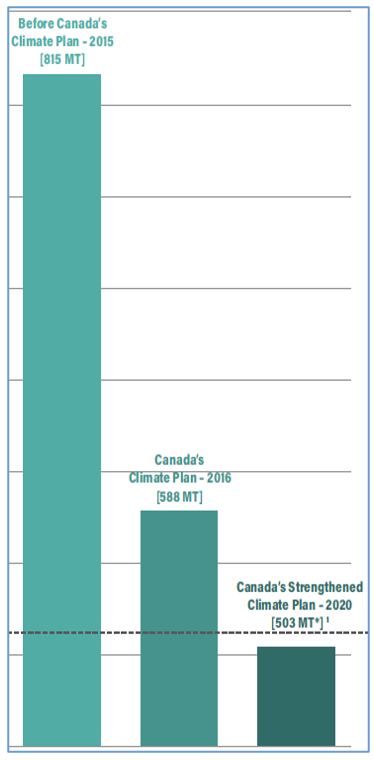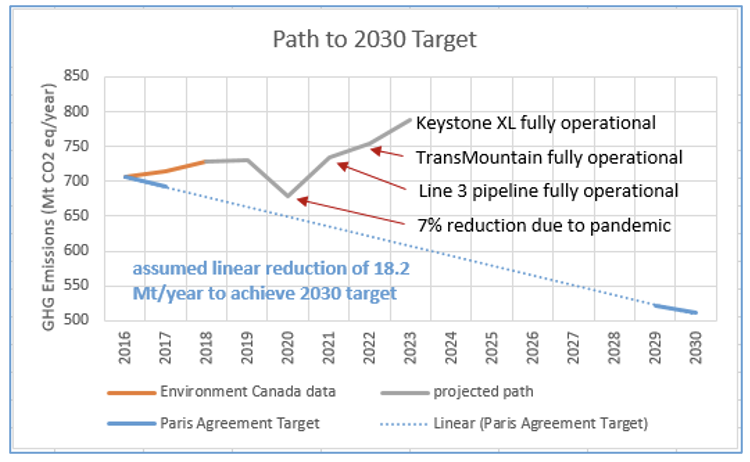 Gordon Prentice writes: Tomorrow (20 January 2021) the newly inaugurated US President Joe Biden will cancel the Keystone XL pipeline as one of his first Executive Orders. Here, guest contributor Walter Bauer (photo right) critiques Canada's 2020 Climate Plan. Walter has discussed his review of the 79 page document with local MP Tony Van Bynen who has promised to pass it on to the Minister of Environment and Climate Change, Jonathan Wilkinson.
Gordon Prentice writes: Tomorrow (20 January 2021) the newly inaugurated US President Joe Biden will cancel the Keystone XL pipeline as one of his first Executive Orders. Here, guest contributor Walter Bauer (photo right) critiques Canada's 2020 Climate Plan. Walter has discussed his review of the 79 page document with local MP Tony Van Bynen who has promised to pass it on to the Minister of Environment and Climate Change, Jonathan Wilkinson.
Walter Bauer writes:
Since 2016, our government has voiced concern about Climate Change. Canada’s 2020 climate plan, “A Healthy Environment and a Healthy Economy” [1] is framed as an extension of Canada’s 2016 “Pan-Canadian Framework on Clean Growth and Climate Change” (published December 9/2016).
Compliance with the Paris Agreement means that Canada needs to reduce its greenhouse gas (GHG) emissions to 30% below 2005 levels (to 511 Mt CO2 eq/year) by 2030. Every year, Environment Canada publishes 2-year old statistics, by sector, of our annual GHG emissions. Its 2020 report shows that our greenhouse gas (GHG) emissions have barely changed since 2005 (see purple square.)
The 2020 climate plan is a 79-page document with 13 Annexes (Appendices). Canadians have one of the highest carbon footprints in the world. It is good we finally have a climate plan but while this plan ticks off most of the environmental boxes, we will not meet the 2030 Paris target. From the plan, a graph, entitled “Exceeding Canada’s 2030 Target”, which appears on page 62, depicts our “starting point” (see page 63) and our targets. Starting in 2016, the Pan-Canadian Framework was to do the heavy lifting, bringing our yearly GHG emission down to 588 Mt/year by 2030. The 2020 climate plan is to do the rest, supposedly exceeding the Paris target, by reducing emissions to 503 Mt/year. The starting point is fiction. Contrary to the climate plan, the starting point is not 815 Mt/year but actually 720 Mt/year (see above), down from 730 in 2005. 
The next bit of fiction is our path to 2030. Four years after what the government would have us believe was its transformational 2016 plan, according to Environment Canada’s 2020 report, our emissions have gone up since 2016 from 706 Mt/year to 729 Mt/year in 2018. But the fiction does not end with our false start.
The climate plan’s next graphic (page 63) is entitled “Progress to Canada’s 2030 Emissions Target” implying there have already been reductions in greenhouse gases. The graphic provides a breakdown by sector of projected reductions in GHG emissions. Most notably, the Oil and Gas sector is shown with the largest reduction of <104 Mt/year> (over twice that of any other sector). This projection flies in the face of the three additional pipelines that are currently under construction in Canada: Trans Mountain, Keystone XL, and Line 3 Refurbishment (began in 2016 and is near complete). If these three pipelines come online as the government intends, Canada’s GHG emissions will increase by 113 Mt[3]/year over 2018 levels. The 113 Mt is a calculation of GHG emissions simply to extract the oil and fill the pipeline, not to burn the oil. Unless the government is relying on the collapse of oil prices and empty pipelines, this continued misguided support of pipelines is based on a “the-more-you-spend-the-more-you-save” mentality, i.e. more fiction.
The government is ignoring added GHG emissions from the augmented oil production needed to fill the pipelines. Continuing with projections beyond the Environment Canada data, by 2023 our GHG emissions will be 8% higher than 2005. Since 2016, we’ve wasted seven years. Only seven years remain to meet the Paris target. Its actions show that our government is not committed to meeting the 2030 target. "Any time a government talks about fossil fuels being some kind of a bridge to a future sustainable world or a stepping stone to dealing with climate change, essentially what that means is we're going to delay the phasing out of fossil fuels."[4]
The pipeline contradiction aside, assuming the reductions touted in the government’s plans have an immediate effect starting in 2021, we will be relying on the following sample highlights, one from each of the “five pillars” in the climate plan, which are all good initiatives but too little, too late:
1. “The Government is proposing to increase the carbon price by $15 per year, starting in 2023, rising to $170 per tonne of carbon pollution in 2030.” This initiative may be the strongest. Revenue neutral, each $15 increase adds approximately $0.03 to the price of a litre of fuel. Over 7 years the price of a litre will increase by $0.21. In Ontario, the current price of gas is approximately $1.10 per litre. By 2030, therefore, it will be $1.31. In 2012, the price was $1.32. Sweden’s carbon tax is now $126 per tonne, it is not revenue neutral and gas is $2.30/litre. According to Environment Canada, in 2015, transportation accounted for 201 Mt/year of GHG emissions (28% of all emissions.) By 2018, it had risen to 218 Mt/year. According to the climate plan, our objective is to reduce transportation emissions by only 12 Mt/year (6% below 2015 levels). Clearly, the government itself does not believe in the effectiveness of its plan;
2. “Invest up to $3.16 billion over 10 years, to partner with provinces, territories, non-government organizations, Indigenous communities, municipalities, private landowners, and others to plant two billion trees.” Newly planted trees have little effect for the first ten years. We already plant 600 million trees per year in Canada, which often provides the excuse for cutting down mature trees. And Canada's forests, because of monoculture, poor management, insect infestation, and mega-fires, are proving to be a net carbon source rather than a carbon sink (documented by Environment Canada);
3. “Provide $2.6 billion over seven years, starting in 2020-21, to help homeowners improve their home energy efficiency by providing up to 700,000 grants of up to $5,000 to help  homeowners make energy-efficient improvements to their homes, up to one million free EnerGuide energy assessments . . .” The number of grants is insufficient to accomplish the climate plan’s unlikely 64% reduction. According to Environment Canada, residential GHG emissions in 2015 were 43 Mt/year. According to Statistics Canada, “of the 12.4 million households in Canada, more than 8.5 million owned their home”[5]. Because this program only addresses “up to 700,000” or 8% of owned households, it will only affect 8% of 43 Mt/year residential emissions, which is approximately 3.5 Mt/year. Based on 421,000 energy audits completed since 2003, largely because of older home retrofits, the average GHG emission reduction per retrofit is 29%[6]. For newer homes the average is lower and in range of 5-15%. A 29% reduction of the 3.5 Mt/year only amounts to 1 Mt/year;
homeowners make energy-efficient improvements to their homes, up to one million free EnerGuide energy assessments . . .” The number of grants is insufficient to accomplish the climate plan’s unlikely 64% reduction. According to Environment Canada, residential GHG emissions in 2015 were 43 Mt/year. According to Statistics Canada, “of the 12.4 million households in Canada, more than 8.5 million owned their home”[5]. Because this program only addresses “up to 700,000” or 8% of owned households, it will only affect 8% of 43 Mt/year residential emissions, which is approximately 3.5 Mt/year. Based on 421,000 energy audits completed since 2003, largely because of older home retrofits, the average GHG emission reduction per retrofit is 29%[6]. For newer homes the average is lower and in range of 5-15%. A 29% reduction of the 3.5 Mt/year only amounts to 1 Mt/year;
4. “Invest an additional $287 million over two years, starting in 2020-21, to continue the Incentives for Zero-Emission Vehicles (iZEV) program until March 2022 [bold added for emphasis]. The program provides a rebate of up to $5,000 on a light-duty zero-emission vehicle”. Prior to Premier Doug Ford’s 2018 cancellation of Ontario’s $14,000 rebate, EVs were among the best-selling vehicles on the car lot. Sales have now collapsed. A federal $5,000 rebate is insufficient to spur the needed conversion to EVs, which are generally more expensive to buy; and
5. “Building Canada’s Clean Industrial Advantage: To make sure that Canadians have good-paying, long-lasting jobs, there is a need to make certain that Canadian businesses are making and providing the low-carbon products, services and technologies.” Given the ongoing research and development in energy storage, concrete, bioplastics, carbon sequestration and agriculture to name a few, the government investment of $5 billion over five years between a Net-Zero challenge, a Low-carbon and Zero-emissions Fuels Fund, and Sustainable Development Technology Canada is inadequate.
In conclusion, since the government’s election in 2015, Canada’s GHG emissions have increased and the climate plan’s investment in reducing GHG emissions is woefully inadequate. This author has no confidence that we will meet our 2030 target let alone Net-zero by 2050. Please prove me wrong.
Walter Bauer, P. Eng.
[1] https://www.canada.ca/en/services/environment/weather/climatechange/climate-plan/climate-plan-overview.html
[2] National Inventory Report 1990 –2018: Greenhouse Gas Sources And Sinks In Canada
[3] Based on 174 kg CO2 / barrel for Alberta oil sands: https://www.pembina.org/blog/real-ghg-trend-oilsands
[4] Dale Marshall, national program manager with the organization Environmental Defence.
[5] https://www150.statcan.gc.ca/n1/pub/11-402-x/2011000/chap/fam/fam-eng.htm
[6] https://windfallcentre.ca/data-tools/retrofit-performance

